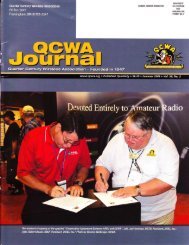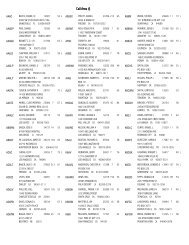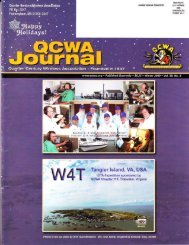G[mloulnal - Quarter Century Wireless Association
G[mloulnal - Quarter Century Wireless Association
G[mloulnal - Quarter Century Wireless Association
Create successful ePaper yourself
Turn your PDF publications into a flip-book with our unique Google optimized e-Paper software.
Chapter 7O, National Capital<br />
Have you ever heard an echo of you or someone<br />
else's signal? Delayed echoes ofup to 1b seconds and<br />
more have been observed as long ago as 1927 when<br />
they were first discussed. Echoei with delays of 1Bg<br />
ms _o1 multiples thereof are explained by around the<br />
worldionospheric propagation. Medium delay echoes<br />
with delay times in the range of from 0.8 to 0.4 seconds<br />
are the result of propagation along the earth,s<br />
magnetic field lines. But long delayed echoes are still<br />
somewhat of a mystery.<br />
Alan Goodacre VESHX has been interested in signal<br />
echoes for many years and has published papeis<br />
on the subject. He has and continues to conduct research<br />
in this area. He and others have heard echoes<br />
over the frequency range from 7b meters to 28 crlr..<br />
Several amateurs in Seattle heard echoes on Zb meters<br />
simultaneously. Keyer bursts were sent while spinning<br />
the dial. The 230 ms delayed signals tracked.<br />
Work done with the ISIS topside ionospheric sounder<br />
d-etermined that they resulted from propagation along<br />
the earth's magnetic field lines. The delay of these<br />
kinds of echoes depends on your location. From Ottawa<br />
they are in the range of from 0.3 to 0.4 seconds.<br />
At 85 degrees North the delay time is 15 seconds because<br />
the magnetic field lines become longer as you go<br />
farther North.<br />
Alan is going to do more experiments this summer.<br />
He has a two times four element 10 meter array<br />
he can elevate and rotate. He tape records his shori<br />
transmissions and any delayed received signals along<br />
with a time signal. Analysis is done witha convolu-tion<br />
process on the computer, which brings very weak<br />
signals out of the noise. His experience is that in operating<br />
for an hour he will get one or two hits. Wi[h<br />
more recorded samples of echoes with delays of a second<br />
or more their origin possibly can be determined.<br />
Two new members, Joe Pakinson VEBJG and Marg<br />
Heaslip VESEQE were warmly welcomed.<br />
Clare Fowler VESNPC - Secretary<br />
Chapter 76, Blue Ridge<br />
Hello, from the Blue Ridge Mountains of North<br />
Carolina, and the town of Hendersonville, home of<br />
Chapter 76. We have a very active QCWA chapter that<br />
meets the first and third Wednesdays, 11:80 AM, at<br />
Ryans Steak House. Visitors to our area are most<br />
welcome to join us at the luncheons. Chapter 76<br />
officers for this year are:<br />
Jim Harrison W4TFT - President, George Knudsen<br />
W4GCK - Vice President, Danny Mellard WA4TOG -<br />
Director, Edith McDade WA4SRD - Director, Duke<br />
Knief W4DK - Secretary, WaIt Steiges W1HTL - Treasurer.<br />
Duke and WaIt are continuing in their officer positions<br />
and that, thanks to them, holds our Chapter<br />
together.<br />
At a recent meeting, we had a wonderful event<br />
when D. B. "Doc" Appleton, K4RR and Bill Symons,<br />
K4IH, received number 18 and number 21 QCWA<br />
26 QCWA fournal - Summer 2001<br />
Doc Appleton K4RR on the left and Bill Symon K4IH on<br />
the right displaying the beautiful eCWA plaques for their<br />
80 years of licensed amateur radio service.<br />
plaques that commemorated 80 years of licensed ama-<br />
teur radio service. Doc and Bill told us of their<br />
early activities in radio and those attending the<br />
meeting thoroughly enjoyed the remarks by these fine<br />
men. Both Doc and Bill continue to be active<br />
hams and active Chapter 76 members.<br />
We have outstanding programs and interesting<br />
speakers at our Chapter 76 meetings and again we<br />
invite all in our area, vacationers too, tojoin us at our<br />
luncheon meetings.<br />
Ghapter 81, Long lsland<br />
Since our holiday meeting in December at the prestigious<br />
Milleridge Inn, our activities have slowed down<br />
due to the approaching winter. It was now decided that<br />
it would be imprudent to continue underwriting portions<br />
of the dinners at expensive meeting places<br />
After much searching we located a suitable restaurant<br />
with modest prices and a separate area where<br />
a meeting could be held undisturbed. A further change<br />
was in the dinner format. It allowed ordering from<br />
the menu. This pleased many members who o6jected<br />
to a limited choice of pre-arranged dinners.<br />
It was arranged to have our first meeting of the<br />
year (Feb.28,2007) at the new place ofour choice. It is<br />
called "Boulder Creek" and is built in western style<br />
like a huge bunkhouse. Although lacking in intimacy<br />
it has a certain western charm. There was an elevated<br />
platform somewhat removed from the general clientele<br />
which was quite adequate for meetings.<br />
The wintry weather limited the attendance to<br />
about l7members who, as always, enjoyed the camaraderie.<br />
Herman Milatz W2ILC - Secretarv<br />
Why does a slight tax increase<br />
Eost you S2U0 and a suhstantial tax<br />
Eut savE you thirty Eents?<br />
-Peg Bracken


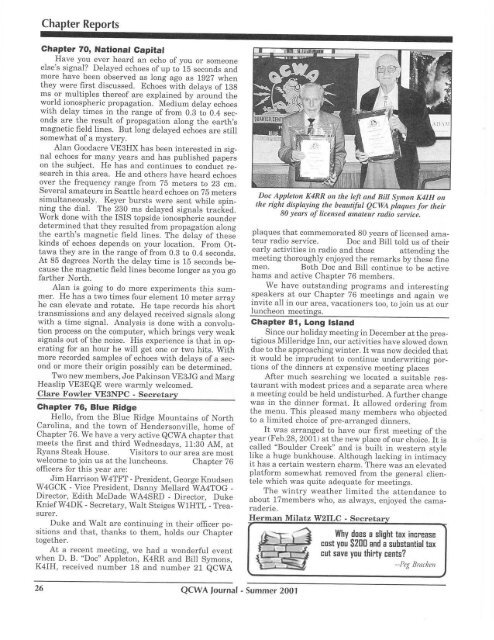
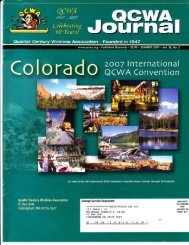
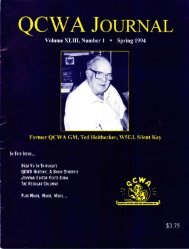
![11{J hI EfifSIt]E I]E - Quarter Century Wireless Association](https://img.yumpu.com/11816560/1/190x245/11j-hi-efifsite-ie-quarter-century-wireless-association.jpg?quality=85)
